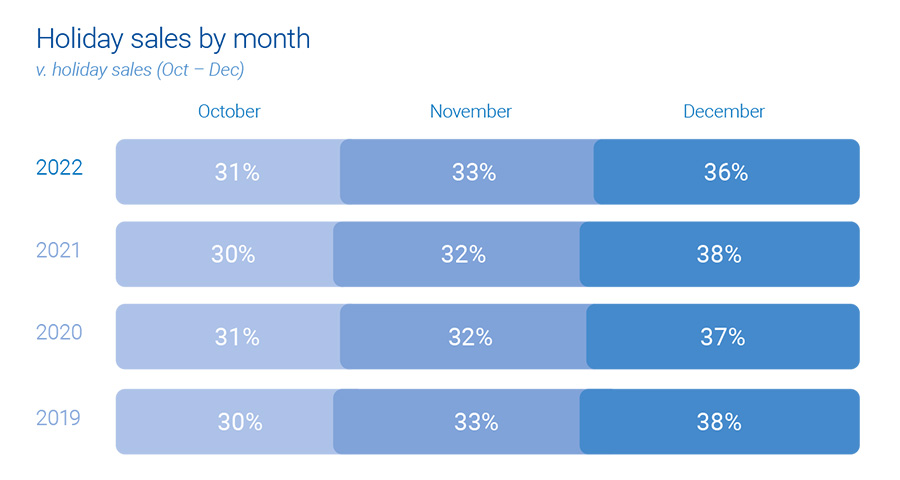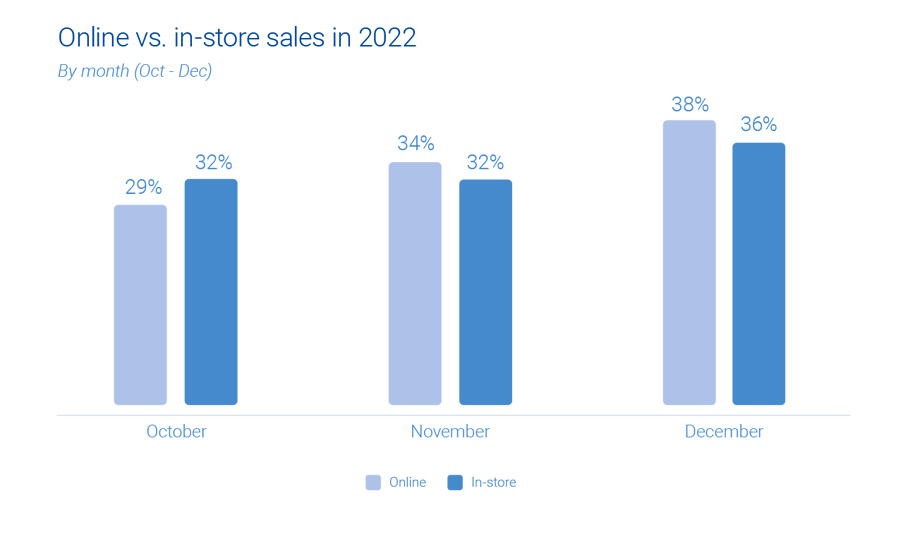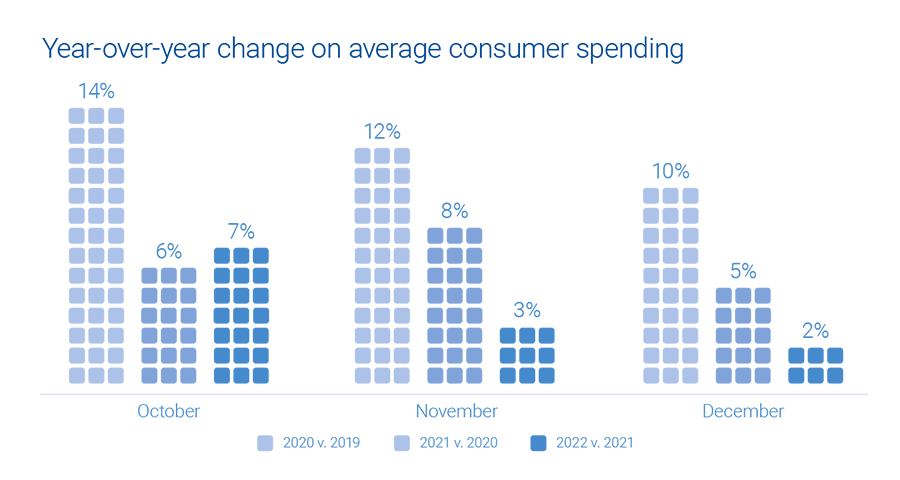
The holiday season is just around the corner, and retailers and marketers are gearing up for the busiest shopping period of the year. It’s crucial to understand how consumer behavior is evolving and what emerging trends to expect. Experian’s 2023 Holiday spending trends and insights report analyzes recent trends, consumer spending habits, and anticipates what’s to come in 2023 to help you deliver a top-notch shopping experience this holiday season.
In this blog post, we’ll cover three key insights from our report.
1. Consumers are shopping earlier
It’s no secret that December has always been the go-to month for consumers when it comes to holiday spending. However, holiday shopping now starts earlier, particularly with online sales.

This can be attributed to a surge in promotions and deals, enticing shoppers to open their wallets ahead of time, giving a significant boost to holiday sales. Notably, Cyber Week sales have proven to be an influential factor, accounting for 8% of total consumer holiday spending.
Experian tip
Reach the right shoppers with your promotions with sell-side targeting. This powerful approach gives you control over where your ads are placed while ensuring maximum visibility through direct connections with publishers. Whether on mobile, web, or CTV, this seamless ad experience will engage your audience effectively.
2. Online sales are on the rise
The popularity of online holiday sales is continuously growing, surpassing in-store shopping. There has been a consistent 1% year-over-year increase in online sales, while in-store sales have seen a 1% decrease.
“It’s easier for consumers to comparison shop for large ticket items online that they might find at a mass retailer or office supply store. Consumers prefer to have larger, bulkier items shipped directly to their home for minimal cost. By shopping online, consumers can save time since they don’t need to wait in checkout lines.”
Anna Liparoto, Sr. Account Executive, Retail & CPG

Although online sales currently make up only one-third of all holiday shopping, there is immense potential for further expansion. Mass retailers and office, electronics, and games industries particularly excel in online holiday sales. While in-store purchases remain the primary choice for holiday shoppers, consumer online and offline activities intersect before the final purchase.
Experian tip
Take advantage of the surge in online shopping by diversifying your marketing channels. An agnostic identity graph can bring together device and media data, capturing valuable user insights. By gaining a holistic view of your target audience, you’ll be able to optimize your ad spend and allocate resources effectively, ultimately boosting your return on investment.
“Omnichannel targeting during the upcoming holiday season will continue to prove to be the best way to reach scale and maximize ROI across all marketing channels.”
Joe LigÉ, Head of Enterprise Demand Partnerships
3. 2023 holiday spending will be on par with 2022
During the holiday season in 2022, consumer spending showed an anticipated increase, although the growth rate was slightly lower compared to previous years. October saw a surge in average consumer spending, indicating a swift response to early discounts and promotions offered by retailers.

As the holiday season progressed, holiday spending gradually slowed down and reached a level similar to that of the previous year. Overall, there was a modest 2% growth. Looking into the future, if economic conditions remain stable in the second half of 2023, we can expect holiday spending to align with the figures from last year.
Experian tip
To truly maximize impact, consider data enrichment. By diving deeper into your target audience’s preferences and behaviors, you can better tailor your strategies and seamlessly integrate the enriched data across various channels. This allows you to unlock the true potential of your ad inventory, creating more meaningful connections with your audience.
Download our 2024 report
Get ready for the holiday shopping season with Experian’s 2024 Holiday spending trends and insights report. Inside you’ll find:
- Analysis of past trends and what they mean for 2024
- Exclusive predictions for the upcoming holiday season
- The top audiences to activate this holiday season
To access to all of our predictions for this year’s holiday shopping season, download our 2024 Holiday spending trends and insights report today.
Latest posts

With all the debate and speculation regarding Groupon and its planned IPO, I thought it would be a great time to check back in with our previous analysis of traffic to Groupon and its nearest competitor Living Social. First, to be clear, the above chart measures web-based traffic to both domains and does not include mobile or app specific traffic. Regardless of these exclusions, the drop-off in Groupon traffic this summer has been significant nearly 50% since its peak in the second week of June 2011 compared to last week. During the same time, Living Social has achieved 27% growth in visits to its site. Overall visits to a custom category of Daily Deal & Aggregator sites were down 25% for the same time. So why is there a narrowing of the gap between the two market leaders in group coupons? Perhaps it is simply a case of increased number of competitors and deal fatigue among consumers or simply not enough of the right deals. PriceGrabber® released results from its Local Deals Survey in June, stating that 44% of respondents said they use or search daily deal Websites. However, 52% expressed feeling overwhelmed by the number of bargain-boasting emails they receive on a daily basis. While consumer fatigue may be one factor another key consideration for these sites is to focus on the attracting new and preferred audience segments via the inbox. Currently the audience segments for both Groupon and Living Social are very similar so it will be interesting to see how both sites and category perform heading into the holiday season.

Newton was only half right: Objects in motion tend to stay in motion, but objects at rest are increasingly becoming mobile. That’s the case, at least, when it comes to the world of today’s mobile consumer. According to exclusive research from Experian Simmons, fully 29% of cell phone owners today believe that their cell phone will be the primary device for their entertainment needs, in the future. Furthermore, a recent report by J.P. Morgan estimates that U.S. mobile ad spending will nearly double in 2011 to $1.2 billion. Screen size and limitations on creative, the report says, present obstacles to mobile advertisers. These obstacles and opportunities make it more important than ever for marketers to understand the behaviors and mindset of the mobile consumer. In this first in a series of blog posts, we will explore some key findings presented in the 2011 Mobile Consumer Report recently published recently by Experian Simmons. Media outlets have started to take note, citing the report in articles here and here. Come back to this blog frequently for further updates, or download the full report today. Mobile Market Overview Cell phone ownership among American adults stands at 91%, up from 72% in 2006. The vast majority of teens, too, have joined the mobile revolution, with 74% of those ages 12 to 17 porting a portable phone, up from 59% in 2006. Even tots are getting into the act, with a reported 22% of kids ages 6 to 11 owning a cell phone today. Among adults ages 22 to 24, the idea of not owning a cell is virtually unheard of, with an astounding 98% of consumers in this bracket reporting personally owning a cell phone. While cell ownership among adults age 65+ is the lowest of any adult segment, it is the fastest growing, having increased a relative 52% between 2006 and 2010. Despite the rise in youth owning cell phones, 90% of all mobile phone owners in the U.S. are adults, a rate unchanged since 2008. Percent of Americans that own a cell phone, by age Mobile Service Providers Verizon maintains its position as America’s number one cell phone service provider, with 32% of all adult mobile phone owners saying they are Verizon subscribers as of May 23, 2011. AT&T also has a sizable share of the market, with 28% of mobile phone owners subscribing to AT&T for cell service. Battling for third place are Sprint and T-Mobile, which respectively claim just 11% and 10% of the mobile market. Smaller, often regional, providers may individually have fewer subscribers, but combined, claim an impressive 22% of the total cellular market. Verizon and AT&T will almost certainly continue to dominate the market, especially given the fact that cell phone subscribers are increasingly staying with their provider for an extended period of time. As of May 23, 2011, the average cell phone subscriber had been with their provider for 3 years and 2 months, up from 2 years and 11 months observed at the beginning of 2008. Furthermore, 59% of cell phone subscribers say they’ve been with their current provider for at least 4 years, up from 46% who reported the same in early 2008. 59% of cell phone subscribers say they’ve been with their current provider for at least 4 years Service Providers’ Share of Cell Phone Subscribers Click here to learn more about obtaining vivid consumer research from Experian Simmons and don’t forget to check back here for new blog posts on mobile consumers.

The popularity of flash sale websites with limited time & inventory offerings have grown exponentially over the two years. Online shoppers’ love for the thrill of snagging designer clothing, home décor, travel and even wine have caused visits to the category to increase 368% in July 2011 as compared to the same month two years ago and 109% one year ago. So far in 2011, Nordstrom acquired HauteLook, Amazon entered the fray with MyHabit and recently Saks Fifth Avenue announced the launch of a dedicated flash sale website after offering sale events per week on Saks’ main website. In July 2011, Zulily.com, a website offering sales targeted for women and babies/kids, captured the highest market share of visits at 16%, followed by Ideeli and LivingSocial Escapes. Amazon’s MyHabit ranked 11th, out of the 87 websites in the custom category after only 2 months in operation. Several of the major players over the past six months, the total visits to Ideeli increased 42%, Gilt.com up 14% and Nordstrom’s Hautelook up 8% for July 2011 as compared to February 2011. Total visits for MyHabit jumped 128% for July 2011 as compared to May 2011 when the website launched. The audience for Flash Sales continues to be attractive, and willing to shop – over-indexing against the online population for household incomes over $100k and creditworthy VantageScores of A and B.